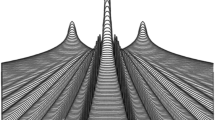Abstract
It is shown that from the expectation values of obervables, which can be measured for a single system using protective measurements, the linear structure, inner product, and observables in the Hilbert space can be reconstructed. A universal method of measuring the wave function of a single particle using its gravitational field is given. Protective measurement is generalized to the measurement of a degenerate state and to many particle systems. The question of whether the wave function is real is examined, and an argument of Einstein in favor of the ensemble interpretation of quantum theory is refuted.
Similar content being viewed by others
References
Y. Aharonov and L. Vaidman,Phys. Lett. A 178, 38 (1993).
Y. Aharonov, J. Anandan, and L. Vaidman,Phys. Rev. A 47, 4616 (1993).
L. I. Schiff,Quantum Mechanics (McGraw-Hill, New York, 1968), pp. 289–291.
W. G. Unruh, “The reality and measurement of the wave function,” unpublished.
S. Kobayashi and K. Nomizu,Foundations of Differential Geometry, Vol. II (Wiley, New York, 1969).
J. Anandan,Found. Phys. 21, 1265 (1991), Sec. 6.
See, for example, D. Pedoe,An Introduction to Projective Geometry (Macmillan, New York, 1963), Chap. X.
D. N. Page and R. Geilker,Phys. Rev. Lett. 47, 979 (1981); J. Anandan, “Interference of geometries in quantum gravity,” to be published inJ. Gen. Rel. Gravit.
R. L. Forward,Proc. IRE 49, 892 (1961); K. S. Thorne, inNear Zero: New Frontiers of Physics (Freeman, New York, 1988), p. 573.
Y. Aharonov and D. Albert,Phys. Rev. D 21, 3316 (1980);Phys. Rev. D 24, 359 (1981).
A. Einstein, B. Podolsky, and R. Rosen,Phys. Rev. 47, 777 (1935).
N. D. Mermin, private communication.
A. Einstein, inScientific Papers Presented to max Born (Oliver & Boyd, London, 1953).
M. Born,The Born-Einstein Letters (Walker, New York, 1971).
For detailed treatments of decoherence in the context of the measurement problem, see H. D. Zeh,Phys. Lett. A 172,189 (1993), and the references therein.
R. Penrose in300 Years of Gravity, S. W. Hawking and W. Israel, eds. (Cambridge University Press, Cambridge,1987). R. Penrose,The Emperor's New Mind (Oxford University Press, Oxford, 1989), Chap. 8.
See, for example, J. Anandan,Phys. Rev. D 33, 2280 (1986).
C. Rovelli, Comment on the paper “Meaning of the wave function,” unpublished.
Author information
Authors and Affiliations
Rights and permissions
About this article
Cite this article
Anandan, J. Protective measurement and quantum reality. Found Phys Lett 6, 503–532 (1993). https://doi.org/10.1007/BF00662803
Received:
Revised:
Issue Date:
DOI: https://doi.org/10.1007/BF00662803




